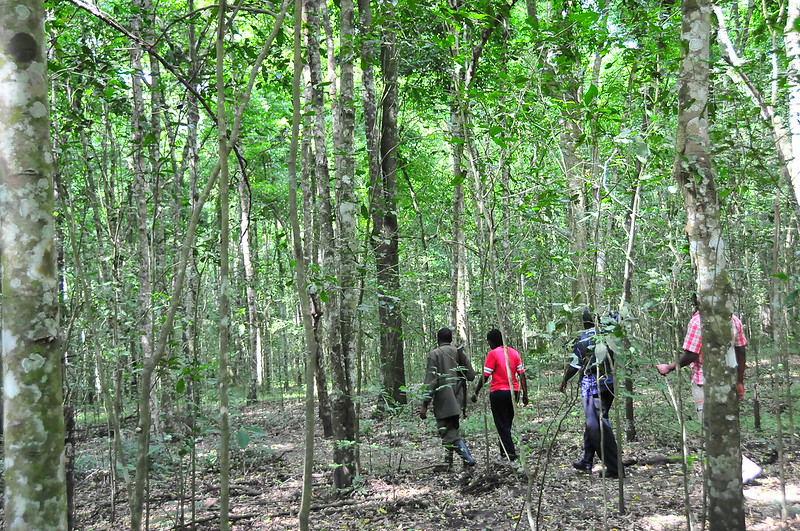Maramagambo Forest, Queen Elizabeth National Park Nature Walks
One of Africa’s biggest natural forests is Maramagambo Forest. It is one of the most popular attractions in Queen Elizabeth National Park, which it borders in the southern section. Many people visit the forest frequently as part of nature study and research tours, as well as on their way to see the hunters’ cave and bat cave.
“Short of words” is how the gahinga word “maramagambo” is translated. This is based on an old story of two skinny kids who went for an adventure and became lost in this enormous forest. It is thought that the more they ventured in this vast forest, seeking guidance to return home, the more confused they became. With a strange story that surrounded the entire hamlet—a kind of African “Hansel and Gretel” tale—it took them several days to find their way back to the nearby community where they had started. The phrase “Maramagambo,” which means “short of words,” originated from the fact that these young people were so fatigued and had not seen anyone in a long time that they were unable to express or speak any kind of word when they returned to the hamlet.
Tourist Activities in Maramagambo Forest
Hiking safaris and nature walks, lasting anywhere from one hour and fifteen minutes to several hours during the day, are best enjoyed in the forest. The half-day hike gives you a chance to see some of the neighboring breathtaking crater lakes. When exploring the lush, green forests, the routes shaded by large trees will provide you with a somewhat different experience than exploring the wide grassland.
Nature Walks in Maramagambo Forest
You may expect to see a variety of tree species and wildlife that call this magnificent forest home during your nature walk. Primates including chimpanzees, L’Hoest’s, black-and-white colobus, red-tailed, blue, and velvet monkeys, and baboons are not to be missed. Insects, butterflies, and bird species are also far more diverse. There are two common nocturnal animals that reside in the forest: pottos and bush infants.
You can come across expanded sections of coordinating soldier ants, also called safari ants, while out on your nature walk. On rare occasions, parts that are 6 meters next to one another and 100 meters long have been observed. As their chomp is venomous, it is best to avoid these warrior ants; fortunately, aside from the uncomfortable sting, their bite has no long-term effects on humans. It is usually advisable to tack in your jeans to prevent contact, since these ants could invade your privacy and cause you to jump abruptly and mysteriously. While on the nature walk, you might come across various creatures. On your lucky day, you might come across pythons, which could lead to a good experience. Although they are abundant in the area, different types of snakes are only occasionally encountered.

Bird Watching
In keeping with bird watching, a variety of forest bird species can be found here in amazing abundance, allowing ardent observers to witness a wide range of species. Exceptional species including the African broadbill, white-tailed lark, Papyrus Gonolek, Papyrus canary, lesser and larger flamingos, and Rwenzori turaco are among them.
Maramagambo Forest's Bat Cave
One of the best places in Maramagambo Forest is the Bat Cave. The Dutch woman who died after returning from a vacation to Uganda with the presumed Marburg virus is the reason the caverns were closed in 2008. Later, the park installed a safe-viewing platform outside the cave where millions of bats can be viewed without worrying about contracting the Marburg virus in collaboration with the American Centers for Disease Control and Prevention (CDC).
How to get to Maramagambo Forest
The forest can be easily reached by the entrance of Queen Elizabeth National Park, located near Jacana Lodge. The bush is located 12 kilometers away from the main route connecting Katunguru and Mbarara. Multiple public buses regularly operate from Kampala bus parks to Kasese, either via Mbarara or Fort Portal. These means of transportation can be utilized to access Kasese town, where you have the option to rent a car that will transport you to the park and the forest.
Nevertheless, we may arrange your visit as part of the whole package, providing you with an opportunity to witness the genuine concealed magnificence of the forest, enabling you to go on an extraordinary forest exploration. The travel from Kampala, the capital of Uganda, takes around 7 hours by car. Mweya, located in Queen Elizabeth National Park, is an airstrip that serves as an alternative option for flying from either Entebbe airport or Kajjansi airstrip. Domestic flights adhere to a daily schedule and will enable you to reach the park in a shorter duration.
